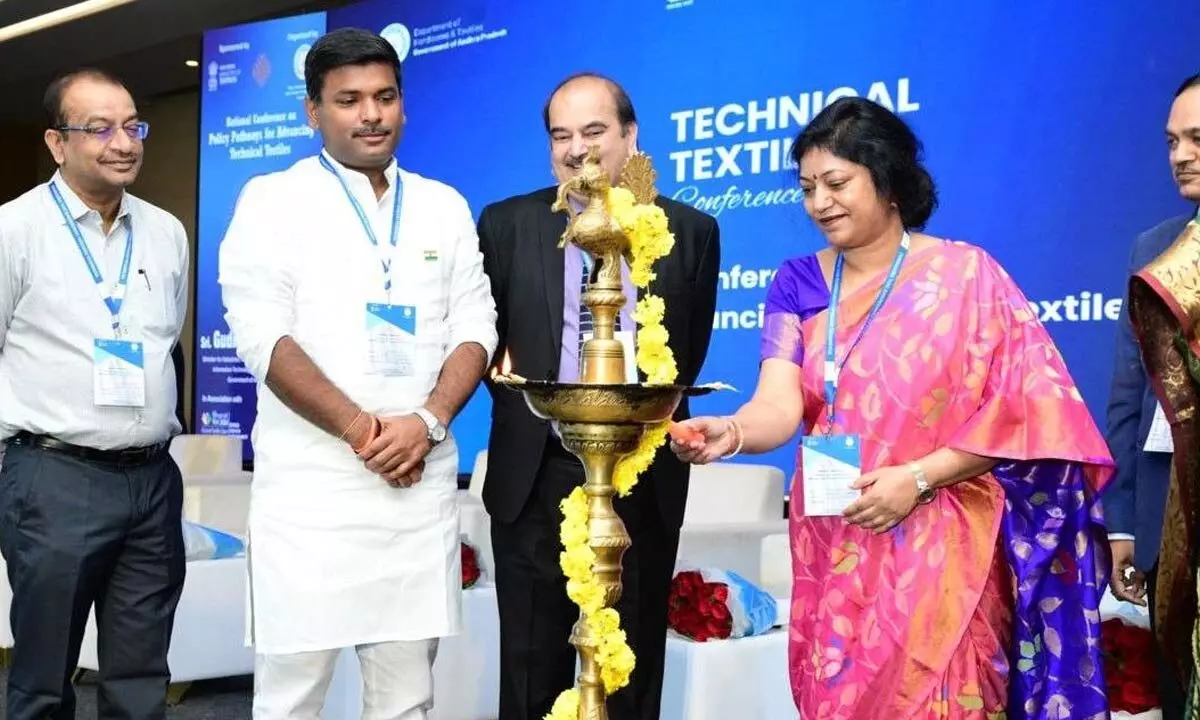Technical textiles will be promoted in big way: Amarnath

Principal secretary K Sunitha lighting the traditional lamp to mark the inauguration of national conference on textiles in Vijayawada on Monday. Minister for Industries G Amarnath,
Commissioner of Handlooms MM Naik and Joint secretary of Union Ministry of Textiles Rajiv Saxena are also seen.
- Aqua sector is a big consumer of technical textiles, says Sunitha, Principal Secretary of Handloom and Textile Department
- UG and PG courses in the technical textiles sector to be designed to attract youth into the field
Vijayawada: Minister for Industries, Investment and IT Gudivada Amarnath said the State government is committed to promoting technical textiles of national and international scope. As part of the “National Technical Textiles Mission”, the State Handloom and Textiles Department on Monday organised a one-day conference here on the theme of formulating policy lines for the development of technical textiles at the national level.
Amarnath, who was the chief guest at the event, said that permissions will be granted in a single window system by providing concessions like no other State in the country has done for the development of the industrial sector.
There is no dearth of land required for setting up industries. He said foreign investment is essential for industrial development and the Centre should be more flexible in this regard.
Rajiv Saxena, Joint Secretary of Union Ministry of Textiles, said the technical textiles sector will play a key role in the development of the country in the coming years. However, he said that efforts are being made to create more awareness on the sector and encourage entrepreneurs. There is a need for skilled manpower in this sector. There is no dearth of funds for the development of the technical textile industry and Rs 1,000 crore has been allocated only for research, he said. UG and PG courses in the technical textiles sector will be designed to attract the youth in this field. Principal Secretary of Handloom and Textile Department, Sunitha, said that aqua is a big consumer of technical textiles. Agro-tech textiles contribute to sustainable agriculture, resource efficiency and waste reduction. While AP is mainly agriculture-based, the net area (including fish farming) is 60.88 lakh acres with 37.35 per cent of the land. Studies show that Agro-textiles in horticulture increase crop production, reduce water consumption by 30 to 45 per cent, and reduce fertiliser use by 25 to 30 per cent.
The future of technical textiles looks promising, with the global market expected to grow from $195 billion in 2022 to $351 billion by 2032. This represents a compound annual growth rate (CAGR) of 6.5 per cent from 2023 to 2032.
Avinash Misar, president of the Indian Textile Association, said that the technical textiles sector will make progress with the formulation of comprehensive procedures.
MM Naik, Commissioner of Department of Handlooms, and noted industrialist Ajay Shiroshi also spoke.
CEOs of various organisations, textile manufacturers, engineers, designers, policymakers and representatives of the government participated in the conference in large numbers. The innovative exhibition showcased useful products made from banana fibre, jute, wool, and other agricultural waste.













